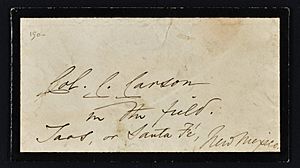Mourning stationery facts for kids
Mourning stationery is a special kind of paper, like a letter or an envelope, that has a black border. People used it to show that they were in a period of mourning, which means they were sad because someone had died.
This tradition started in Europe in the 1600s. It became very popular during the Victorian era, which was from 1837 to 1901. During this time, it was also used in the United States and parts of West Africa.
The black border on the stationery could change. Sometimes it started thick and then got thinner over time. The thickness could also show how close the person was to the person who died. For example, if a child passed away, the border might be thicker than if a distant cousin died. In the past, when people received a letter, they often had to pay to get it. Society expected people to show their sadness both in public and in private. If a king or queen died, public notices, newspapers, and government papers might also have a black border.
It was generally understood that children did not use mourning stationery. If people used special seals to close their letters, these seals were usually black too. Sometimes, black borders were also used on letters that announced very serious public events.
Contents
What is Mourning Stationery?
Mourning stationery is paper with a black edge. It was a way for people to show they were grieving. This special paper helped others know that the sender was in mourning. It was a common way to communicate sadness in a formal way.
How it was Used
The black border was a visual sign of loss. The width of the border could tell you about the sender's grief. A wider border often meant a closer family member had died. This custom was part of a larger set of social rules about mourning. It showed respect for the person who had passed away.
A Look Back: History of Mourning Stationery
Mourning stationery has a long history. It became a very important custom in the 1800s. When Queen Victoria died in 1901, many stores sold mourning stationery. This was a way for people to honor her memory. American newspapers in the 1800s also used black borders. They would put these borders around death announcements.
Royal Traditions and Changes
The British royal family has a long history with mourning customs. After Prince Albert, Queen Victoria's husband, died in 1861, Queen Victoria started using mourning stationery. This set a strong tradition for the royal family.
However, when Prince Philip, Duke of Edinburgh died in 2021, Queen Elizabeth II chose not to use the black border. This was a break from the long-standing tradition. Even though the Queen did not use it, Prince Charles (who is now King Charles III) and Camilla continued to use the mourning border. This shows how traditions can sometimes change or be followed differently.
See also
- In memoriam card


